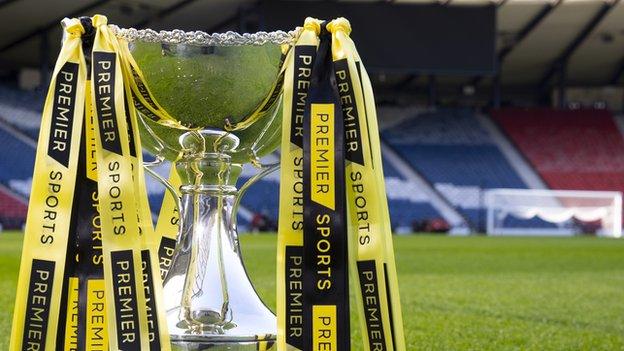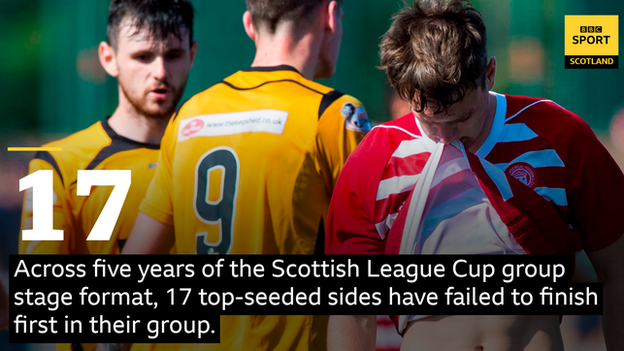Scottish League Cup: Lessons learned from five years of group-stage format
- Published

The Scottish League Cup is going into its sixth season using the group-stage format
It has been five years since the Scottish League Cup was shaken up, with a group stage format introduced, European participants given a bye, and non-league teams included.
The change has brought a freshness to the competition, as well as enhanced media coverage, but it has also been criticised as stale, with repetitive fixtures an issue.
With the fifth iteration of the format upon us, BBC Scotland looks what lessons can be learned.
You can bet on an upset
With a seeding system and only one team from each of the eight groups guaranteed to make it through - along with four best-placed runners-up - there were concerns about whether it would be harder for smaller sides.
Those were quashed in the first season, as four top seeds - Dundee, Ross County, Motherwell and Kilmarnock - all failed to finish first in their groups.
The following year, five did likewise, with Hearts' particularly underwhelming campaign doing for head coach Ian Cathro.
In the three campaigns since, eight top-seeded sides have not won their sections - including Hamilton Academical last term, with the then top-flight side picking up six points from four games after defeats by Annan Athletic and Stranraer.

More games = more coverage
Scottish football is often lambasted for its failure to market itself properly, but the group-stage format opened a door to further televised coverage for teams away from the usual spotlight.
BT Sport's highly-praised coverage gave the competition more scope from the 2016-17 campaign, televising various matches throughout the summer group stage, before Premier Sports gained the rights last season.
The current broadcaster has also recently been announced as the competition's leading sponsor until the end of the 2026-27 campaign, with their deal in place for at least the next two years.
SPFL chief executive Neil Doncaster said Premier's involvement has "enhanced its [the cup's] prestige and awareness" and their sponsorship "offers a new and exciting promotional platform".
Time to bin regionalised draw?
One persistent negative with the League Cup group stage is the repetitiveness in fixtures.
A regionalised format sees teams split into north and south sections which, coupled with the seeding system, means there is less variety on offer when it comes to the draw.
For instance, in four of the five years Hearts have competed in the group stage, they have been drawn in the same section as Cowdenbeath three times.
Also, in this season's draw, Robbie Neilson's men have been drawn in the same group as Inverness Caledonian Thistle - the third time in four seasons the Tynecastle side have been in the same section as the Highlanders.
Could a switch away from the regionalised method give the format a new lease of life? On the other hand, that would limit the likelihood of local derbies.
Throughout the five years we have seen Dundee and Ayrshire derbies contested at the group stage, while Motherwell and Airdrieonians' Lanarkshire rivalry will be reignited for the first time in over decade this season.
Derbies appease both fans and the broadcaster, so perhaps the regionalised draw may be here to stay for now.